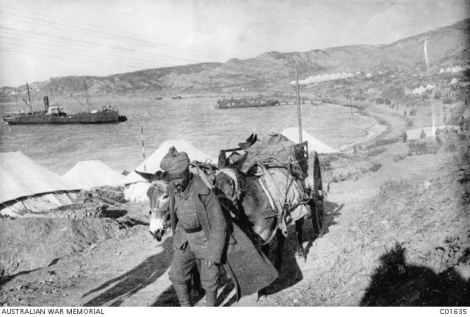On 15 August 1914 the 1st Division was initially formed as the Australian Imperial Force (AIF).
In the August offensive a year later the 1st Division’s role was to hold the front line and conduct a diversion at Lone Pine.
A further year on in August 1916 Gunner Holmes, recovered from injuries incurred at Lone Pine, embarked for France.
In these two years Louis Aaron Holmes (1886-1960) saw less than two month’s active service. I remember my great uncle Lou as quiet and a man to be respected in the way great uncles should be. Comments by repatriation doctors paint a different picture. And when I look at the record of his military service I begin to understand why.
Louis Aaron Holmes enlisted on 1 October 1914 having emigrated to Victoria from Woolwich, Kent just a year beforehand. He was taken on with the 1st Division Ammunition Column Reinforcements and was to become a gunner in the 4th Battery of the 2nd Field Artillery Brigade.
There is a glimpse of his service and the possible effects in his military personnel records. What Uncle Lou did in the war and afterwards is better understood on reading his repatriation records as well as exploring relevant World War I unit diaries.
Uncle Lou sailed from Melbourne on 22 December 1914 and arrived in Egypt two months later. Here the Divisional Ammunition Column Reinforcements underwent further training in Egypt. Some were taken on strength for the Anzac campaign but Uncle Lou did not get to Gallipoli Peninsula until the middle of July 1915. And perhaps I would never have known just precisely where he was if it weren’t for mention of his first misadventure to the repatriation medical staff.
In establishing that his injuries were war related Uncle Lou mentioned to Repatriation that his hernias were due to placing the two three pounder Hotchkiss guns. These guns were taken over by his battery on 29 August 1915 and placed on Russell’s Top. It seemed from Uncle Lou’s recollection that a horse took fright or some part of the gun carriage snapped leaving Uncle Lou taking the full weight of a Hotchkiss gun.
A few days later 15 effective rounds were fired from one of the Hotchkiss guns before its sights were damaged and the gun pit badly damaged. The Lieutenant and seven other ranks were evacuated by the Medical Officer. I believe that Lou Holmes was one of those other ranks. While his most severe injuries were received in placing the guns he also received some shrapnel wounds when when the gun pit was damaged.
That period from the middle of July 1915 to the beginning of September was the total of Uncle Lou’s active war service until he joined his unit a year later on the Western Front.
He was evacuated from Gallipoli Peninsula by the Hospital Ship Nile to Malta where he was recorded as having dysentery, piles and rupture. The more badly injured men were returned to Australia from Malta but Uncle Lou was transferred by the Hospital Ship Hunslet bound for England. Here started his journey to recover from his wounds, to get fit, train and join his unit preparing for the war on the Western Front. His journey included seven months in London hospitals and periods at the Monte Video Camp at Weymouth Dorset, Perham Downs near Salisbury, Wiltshire and finally Bulford Cam, also on the Salisbury Plains, before undergoing further training in France in August 1916.
Selected Bibliography:
National Archives of Australia, NAA B2455 Louis Aaron Holmes Service Number 3434
National Archives of Australia, NAA B73 H34661 and M34661 Repatriation personal hospital medical case files, World War I Louis Aaron Holmes Service Number 3434 4th Battery, 2nd Field Artillery Brigade
Australian War Memorial AWM4 Australian Imperial Force unit war diaries, 1914-1918 War including Subclass 13/10 Headquarters 1st Australian Division Artillery, Subclass 13/30 Headquarters 2nd Australian Field Artillery Brigade and Subclass 13/66 4th Battery Australian Field Artillery diaries.Image courtesy Australian War Memorial www.awm.gov.au/collection/C01635 A driver guides his pair of mules and AT (artillery transport) cart up a slope near Anzac Cove.
